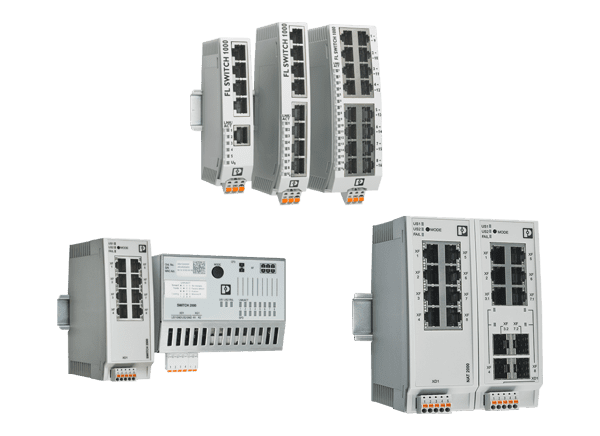- support@husseinkey.com
- livechat
Phoenix Contact Ethernet Switches provide reliable, efficient data exchange and can ensure the robustness of networks. Phoenix Contact offers the right switch for every application. The portfolio includes switches for managed, unmanaged, intelligent, and layer 3 with DIN rail or field device options available. Phoenix Contact Ethernet Switches also offer support for various IT standards and automation protocols such as PROFINET and EtherNet/IP™. Gigabit switches support large networks with high data throughput while Power over Ethernet switches are ideal for the use of cameras and other PoE end devices.

Unmanaged switches include standard functions, a variable number of ports, and various designs. In addition to switches for DIN rails, Phoenix Contact offers switches with a 19″ design and switches for field installation (IP67). The fast Ethernet and gigabit switches offer a high level of immunity, robust housing, and a wide temperature range, making them suitable for continuous operation in industrial applications. Special versions for PoE make it easy to install end devices. Unmanaged switches are ideal for set-it-and-forget-it applications and best suited for applications that don’t need network redundancy.
Learn More


Managed switches offer optimum real-time properties, prioritization of data traffic, various options for network diagnostics, and redundancy mechanisms. The robust DIN rail switches are tailored to special requirements in industrial environments and the automation protocols used there, including PROFINET and EtherNet/IP. Gigabit switches support large data volumes. They are also available as PoE switches. Options include 5 to 24 ports, copper or FO connections (SC, ST/BFOC, SFP), and various approvals. Managed switches are best for applications that are more data-intensive and require full features like VLANs, high-speed redundancy options, and automation-specific protocol configuration.
Learn More


Intelligent switches combine the simplicity of an unmanaged switch with the intelligence of a managed switch. If the Ethernet switch is used in unmanaged mode, it behaves like an unmanaged switch. In other words, it does not use an IP address and does not need to be configured. But it still offers additional functions for ensuring network robustness such as redundancy mechanisms and filter functions. In managed mode, the various options for quick and easy switch configuration simplify startup and offer diagnostic functions for networks. Intelligent switches are best suited for applications that need common management functions without all the bells and whistles. Traffic filtering, basic redundancy, easy configuration, and network counters are all included.
Learn More


Industrial layer 3 switches allow engineers to segment networks into several subnets. These switches easily integrate existing machines, systems, and subnets into the higher-level network, increasing network stability and security. Switches with NAT functionality easily integrate systems with identical IP address ranges into higher-level networks. Layer 3 switches are best for more advanced applications that have several network segments. Routing and NATing are included, along with the normal managed switch capabilities.
Learn More









